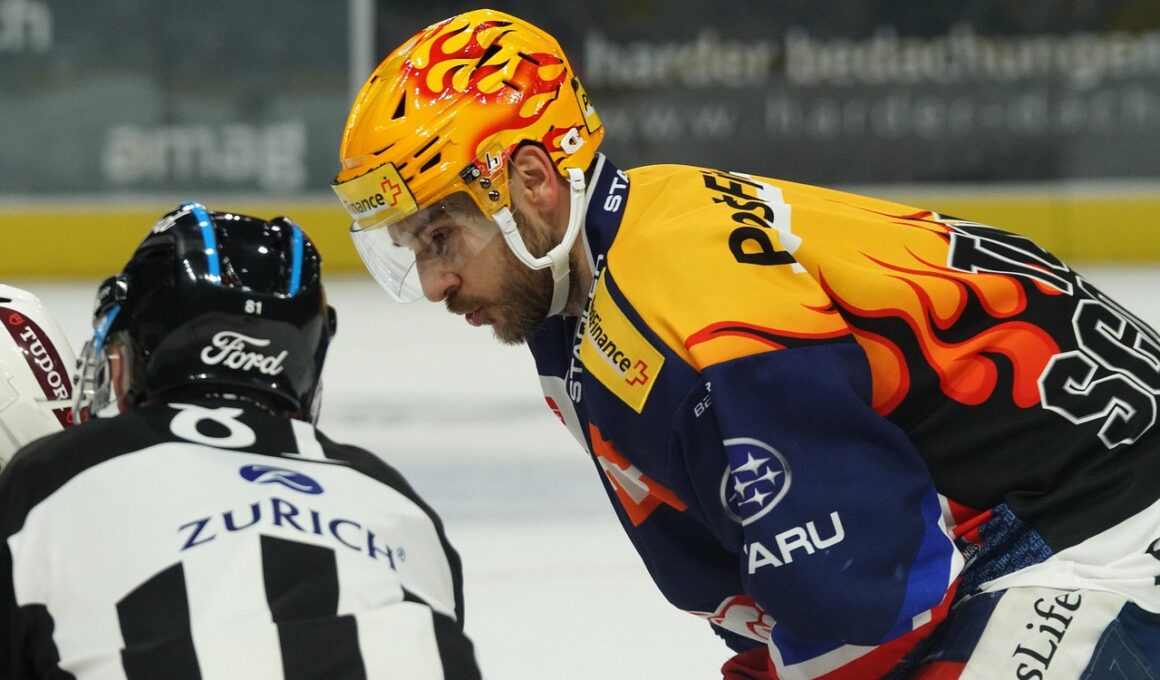Effective Checking Techniques in Ice Hockey
Ice hockey checking techniques are critical for defensive players. A solid understanding of checking improves overall gameplay effectiveness. Properly executed checks not only safeguard your team but can also turn the tide of the game. It’s vital to learn the differences between body checks, hip checks, and shoulder checks. Understanding these can grant you a strategic advantage on the ice. Practicing these techniques in drills helps players refine their skills. Players must also be aware of the rules surrounding checks to avoid penalties. Checking too aggressively or with improper form leads to serious consequences. Remember that hockey is a contact sport, but safety is paramount. Always be aware of your surroundings and the players around you. Positioning is crucial for effective checking, as proper angles make checks more efficient. Initiating contact at the right time ensures that you achieve successful checks without causing injury. Learning to skate well and maintain balance is essential for performing checks effectively. Skillful checking can set your team up for offensive plays, shifting momentum as you regain possession of the puck. This creates opportunities during the game. Players who master checking are invaluable assets to their teams.
Checking is not just physical; it is as much cerebral as it is bodily. Reading your opponent’s movements allows you to anticipate their actions. Effective checking requires diligent practice and good communication with teammates. Always navigate the ice with the intention of protecting your teammates. Understanding when to engage is key – too early and you risk missing your target, too late and you let your opponent advance. When positioning for a check, always bend your knees slightly for stability and leverage. Engage your core to generate power and control during the check itself. Engaging the hips by shifting your weight appropriately further enhances your overall stability and effectiveness. Timing is crucial, as delivering a check at the right moment can catch your opponent off guard. Always maintain your composure even in high-pressure situations to ensure your checks remain productive, not reckless. Additionally, consider the size and strength of your opponent, matching your technique accordingly! Engaging in scrimmages that focus on checking practice sharpens your skills further. Always wear protective gear during this practice, ensuring your safety in drills. Consistency and attention to detail will lead to improved technique and confidence on the ice.
Understanding Different Types of Checking
Several types of checks are fundamental to ice hockey. The most common type is the body check, which involves using your body to stop or steer an opponent off the puck. This is usually executed when the opponent has the puck and is trying to maneuver past you. A well-timed shoulder check can also serve the same purpose effectively. While performing a body check, it is crucial to use your shoulders and legs to absorb the impact while maintaining balance. Another important check is the hip check, which utilizes your hip to knock an opponent off balance. This is particularly effective when approaching from the side. Additionally, players can employ stick checks to disrupt an opponent while still maintaining their skating position. A well-timed poke check may also prevent passes or shots from reaching their targets. Remember that each check requires finesse, control, and timing. To effectively execute any checking technique, remember to engage your entire body, not just your arms. Practicing these various checks will provide you with a arsenal of checking methods to deploy during games. Understanding when to use each technique is equally essential for success on the ice.
In ice hockey, understanding the rules concerning checking is vital to ensure gameplay remains clean and competitive. This encompasses various aspects, including proper body position and contact points. For instance, checking from behind or delivering a head check could lead to serious penalties or worse yet, injuries. Consequently, as a player, it is essential to stay updated on the regulations that govern checks. If in doubt during gameplay, always prioritize safety for yourself as well as your opponents. While aggressive play is often encouraged, it should never compromise ethical sportsmanship. Checking should also be distinguished from hitting, as the latter may occur without any intention of puck possession. Emphasizing responsibility while checking helps promote positive team dynamics. Players should also understand the common troubleshooting situations arising from faulty checks. These can lead to injuries or missed opportunities. Conversely, an effectively executed check can yield rebounds or create fast-break scenarios. Practicing checking techniques in drills can help develop rhythm and synergy within your team. Coaches can establish specific drills focused solely on checking, fostering improvement over time. Such practice ensures players gain confidence in their checking abilities to perform effectively in competitive matches.
Practicing Safe Checking
Player safety is paramount in any sport, especially in ice hockey. Practicing safe checking techniques dramatically minimizes the likelihood of injury for yourself and opponents. Coaches and players alike should emphasize the importance of safety drills and how they relate to physical play. Learning the fundamentals cannot be understated; understanding how to position your body, keep your head up, and make sure your arms remain close to your side is essential. One technique to practice safe checking is through controlled scrimmages focusing on checking drills. This allows players to work on their positioning without the heightened risks of full-speed games. Furthermore, utilizing padded equipment during practice can help prepare players for physical interactions that occur during games. Always encourage players to think critically during both practice and gameplay; assess the situation before committing to a check. This thought process minimizes reckless approaches to checking. Reviewing videos of professional games may also assist in identifying effective checking techniques in action. Moreover, open discussions about experiences and techniques can deepen players’ understanding. Always remember: Safety should be a priority for you and your teammates preventing injuries will maximize everyone’s enjoyment of the game.
The role of communication cannot be underestimated when employing checking techniques. Frequent communication with teammates makes effective checks possible. Simply calling out your intentions can help friends position themselves accordingly for offense or defense. Collaborative checks, where two players approach an opponent simultaneously, can be especially effective. Timing these actions and communication can lead to turnovers that catch opponents off guard. Identifying the strengths and weaknesses of your teammates will allow you to support them as you employ techniques in tandem. Quick calls like “check right” or “I got him” produce amazing collaboration. Mark your opponents clearly, enabling other players to anticipate their moves effectively. Additionally, remember to watch your teammates and adjust your approach based on the situation. Engaging with your team-building activities outside games can reinforce communication skills. Strategies practiced together facilitate seamless transitions during dynamic gameplay. Including your goalie in strategy sessions allows you to work cohesively, enhancing overall gameplay. Keeping a calm demeanor during a game will also improve communication effectiveness and thus your team’s performance. Engaging in both practice drills together and playing games facilitates understanding how communication flows naturally among teammates. Such strategies will help utilize checking effectively and safely.
Continuing Improvement in Checking Skills
Developing checking skills is an ongoing journey for every hockey player. Continuous practice and review of techniques are essential to stay sharp and effective on the ice. Regular coaching feedback can identify areas for improvement in each player. This ensures that players remain aware of correct body positioning and execution of checks. Video analysis can also serve as an excellent tool for understanding your checking style in various scenarios. An additional resource comes from seeking advice from seasoned players who may impart useful tips they have learned throughout their careers. They can highlight common pitfalls players encounter while learning. Engaging in off-ice training, such as strength training and stretching, can complement your on-ice practice. This physical preparation is crucial for generating power, preventing injuries, and improving overall agility. Furthermore, participating in clinics or camps focused on skating and checking techniques presents new learning opportunities. Regular competitive play will solidify your learned skills and allow real-time application against different opponents. Establish goals for your skill improvement to stay focused and motivated. Remember that mastering checking takes time and dedication; however, the benefits are well worth the effort in the long run. Players committed to continual growth will find success.
Establishing a robust foundation of checking skills is essential for becoming a well-rounded player. Every hockey enthusiast should be eager to learn and master the necessary techniques effectively. Prioritize regular engagement in continuous practice to hone your skills and ensure improvement over time. When players fully commit to refining their techniques, they set the stage for personal and team development. Remember to remain patient throughout this journey, as mastery won’t come overnight. Celebrate small victories along the way – they add up! Recognize your improvements in executing effective checks during play and appreciate them. Supporting fellow teammates on this journey ensures that everyone thrives, creating a unified team environment centered around trust. Understanding that ice hockey is a collaborative sport encourages a team-focused mindset, fostering accountability among players. Create a culture where constructive feedback becomes the norm; shared successes promote growth within a team. Encourage each other to remain committed to their development journeys. Additionally, select times to introduce new challenges or drills that enhance your checking acumen, ensuring continual improvement. As you progress, never forget the importance of safety and sportsmanship on the ice. Mastering checking techniques will ultimately enhance your playing experience and ability.


